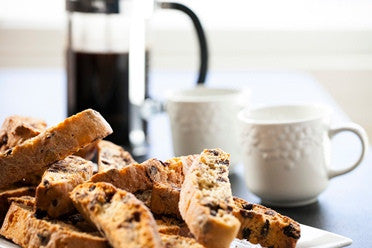Traditional, Italian biscotti is what comes to most peoples' minds when they first think of a twice-baked cookie. This technique calls for the baker to shape the dough-y batter into loaves, bake them once & then slice them down and bake the product once again.
This second bake ensures that the result is a reliably hard, crispy crunch that comes from slowly drawing all the moisture out of said batter. Marlos are baked off and finished in the very same manner, and yet the crumb is a bit more tender, the crunch not quite so aggressive. Despite these differences, it's clear from cookie history that Marlos exist today because of the centuries old technique that originated with biscotti.
The term biscotti comes from the medieval Latin word biscotus meaning 'twice cooked or baked'. The first documented recipe for the biscuit was found in an eighteenth century manuscript, now preserved in Prato, Italy. This original recipe was composed exclusively of flour, sugar, eggs, pine nuts & almonds. There was no added fat to the recipe to ensure that the end product would remain crispy & dry and thus stay edible for a longer time.
A few years later, not far from Italy in Eastern Europe, Jews were making their own version of biscotti called mandelbrodt, or almond bread, translated from Yiddish. Identical to biscotti in technique, the doughy mixture was formed into loaves and baked twice. The dry cookies were popular in Eastern Europe among rabbis, merchants and other itinerants as a staple dessert that kept well in a time without preservatives and refrigerators.
In the Ukraine, the mandelbrodt was referred to a kamishbrot, or 'mixture bread'. While crunchy like biscotti, the recipe often included walnuts & chopped fruit, resulting in a cookie with more heft & substance. Kamishbrot (or kamish bread) is what my Grandmom always called these cookies that became a tradition of my adolescence & a delivery to look forward to.
One of the most fun parts about vending at places like the Underground Market & the Treasure Island Flea is seeing people make a connection to a familial memory when they eat a Marlo. The cookie's shape & flavor reminds them of their mothers or grandmothers who had a biscotti or mandelbrodt recipe of their own. And then they smile.
Seeing those smiles makes me hope that this new generation of Marlos will inspire sweet, future memories while holding on to traditions rich in history.
Liquid error (templates/article line 39): Could not find asset snippets/relatedblogs.liquid

